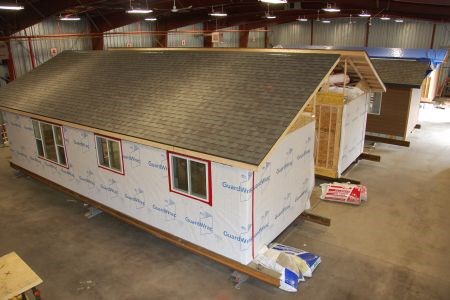A modular home builder has expanded into buildings on a former Abitibi paper mill site in Kenora.
The arrival and production start-up of Wincrief Homes is the first tenant on what a Winnipeg development consortium and the City of Kenora hopes will spawn some new value-added businesses for the brownfield site.
The new owner of the Abitibi lands is a Manitoba numbered company headed by Marcel Chartier, a highly successful Winnipeg commercial real estate broker, who is also CEO of CB Richard Ellis Manitoba.
The deal, which closed in March, comprises a 400-acre series of parcels of land consisting of the mostly-demolished mill site and some picturesque waterfront property on the Winnipeg River system where it empties into Lake of the Woods.
Wincrief has leased an abandoned warehouse and training centre for the assembly plant, which began operations in May, and for a future utility pole business.
Headed by CEO Greg Moncrief, the company expanded into town this spring from a Redditt Road factory location on Kenora's outskirts. Wincrief produced 22 modular homes in its last fiscal year and is hoping to match that output again.
The home construction company is a spinoff of family-owned parent company, Wincrief Forest Products, and is a joint venture partnership between Moncrief Construction and local Wabaseemoong Independent Nation.
Tannis Romaniuk, Wincrief's executive operations and networking manager, said they are working hand-in-hand with Chartier on a number of exciting First Nation-related businesses that are looking to partner with them and set up shop on the mill property.
“We have to sit down (with Marcel) to review them and see how we want to proceed.”
Wincrief has plenty of irons in the fire.
The company has secured work with two Manitoba developers to build affordable homes for a waterfront community project on the site of the famed Minaki Lodge, north of Kenora, that burned in 2003.
Conversions have also started with First Nation communities in Manitoba that were impacted by last spring's massive floods.
Moncrief will have a utility pole plant operational by this fall and Chartier expects him to land some major contracts.
Supplying homes for remote First Nations is Wincrief's target market, but one customized model was sold to a local couple.
Romaniuk said one barrier the company must overcome is the public perception in their home market, that First Nations housing is substandard.
She said they're well-constructed and built to high standards with a layer of oriented strand board behind the drywall to add rigidity, buffer noise and increase the insulation value.
It has to stand up to the rigours of the ice road where Wincrief shipped eight homes by flat bed to Deer Lake First Nation.
Another barrier is a shortage of skilled labour.
With only 10 employees, Romaniuk said Wincrief places a premium on training local Aboriginal people to be carpenters, electricians and plumbers, but there are not enough mentors around.
“Part of the main goal here is build the communities.”
The company wants to partner with other First Nations to train an Aboriginal workforce in their home communities.
“We want you to buy our houses, but we also want to leave you with skilled people that can look after those homes.”
Romaniuk said they also hope to strike a relationship with Confederation College to assist with an apprenticeship program with basic educational upgrading courses.
Romaniuk said it's difficult for Wincrief to do it on its own dime.
“There's a real lack of skilled trades and it's hard to fill that void when you're paying the dollar yourself.”
The sincerity of the company is not lost on Chartier, who inherited the Abitibi lands project from his cousin John Gale of Kenora.
He heaped praise on Moncrief calling him “a shrewd, sharp businessman” whose intent is “more than just making money for himself.”
Chartier said his group's intent is to help the community redevelop the property and restore some of the lost jobs and $60 million in payroll lost after Abitibi shutdown in 2006. “That's foremost in my mind.”
The entire land package offers great development potential for a mix of industrial, commercial, retail and residential, such as a hotel, apartments and condos, but Chartier is cautious in revealing how things will unfold, citing highly confidential discussions.
“We didn't buy the land to sit on it. We bought it primarily because it was a sizeable parcel of land which has very diversified potential uses.”
Some initial ideas include a seniors complex and a mobile park of double-wide trailers for the 55-plus crowd.
Chartier stressed market conditions and orderly planning will dictate how the development will look. Though wanting to “hit the ball out of the park” with a series of quality and affordable projects, Chartier said his consortium is patient enough to let the development roll out in stages.
“We'll market it one piece at a time.”
The City of Kenora has enacted a development tool to help market the industrial uses of the Abitibi lands.
A community improvement plan is in place for the mill site in offering tax incentives for other businesses to locate there.
Economic development officer Jennifer Findlay said the incentive program has received widespread community support for its intent to create jobs and increase tax assessment.
In presenting the plan to the public, Findlay said what's universally favoured is the creation of a modern and “aesthetically pleasing” light industrial business park
“For the redevelopment of this site, people talked about small- and medium-sized business opportunity, First Nation job creation, a value-added business cluster and the idea that it doesn't have to look like a former industrial site.




